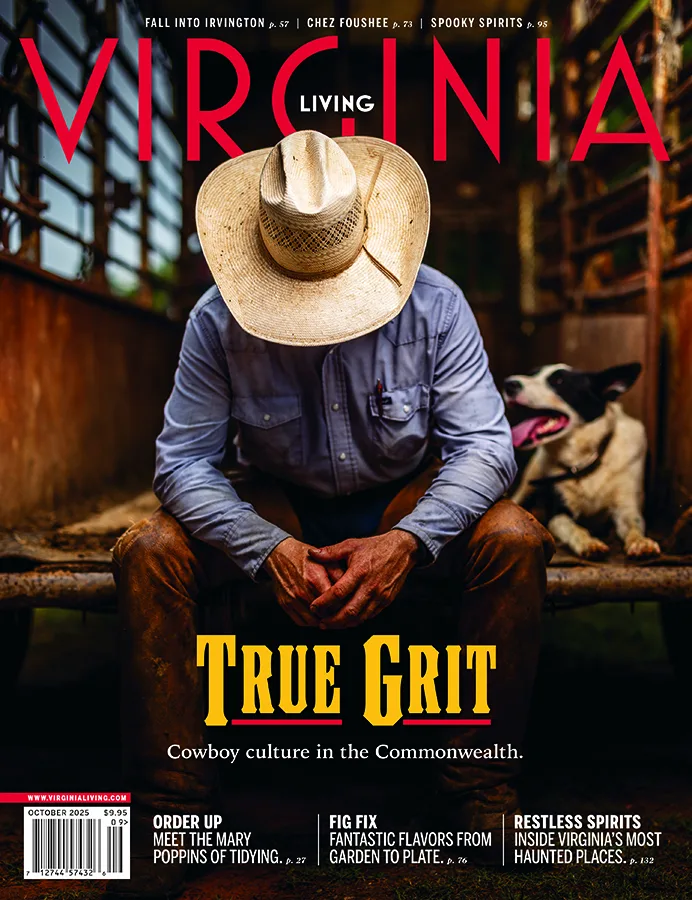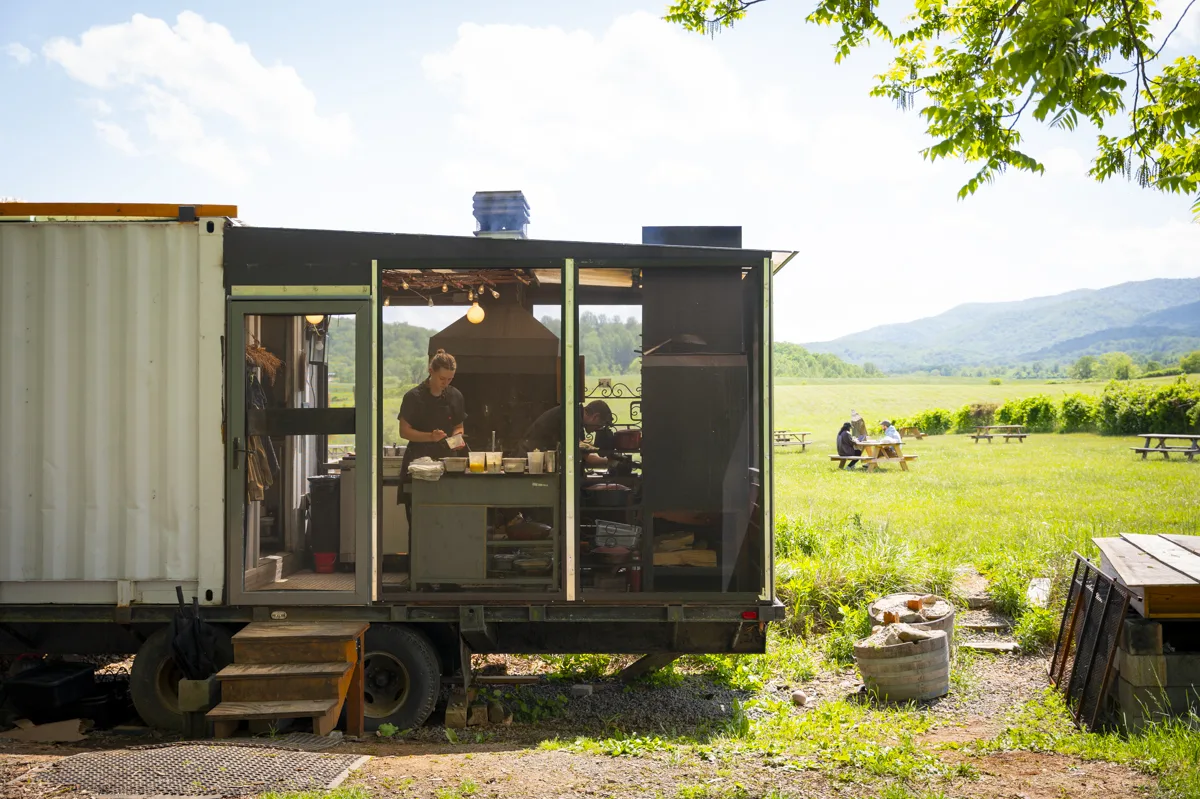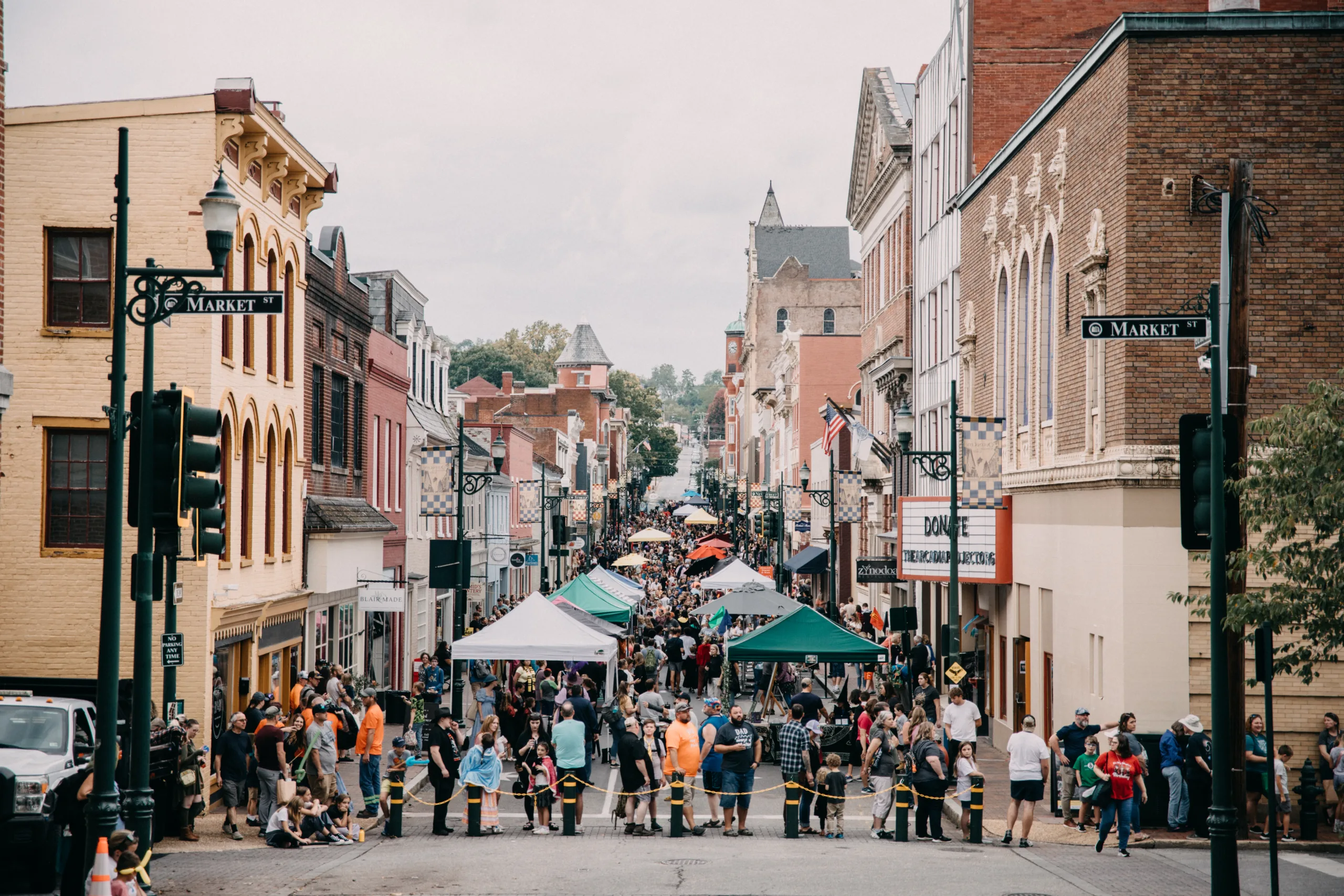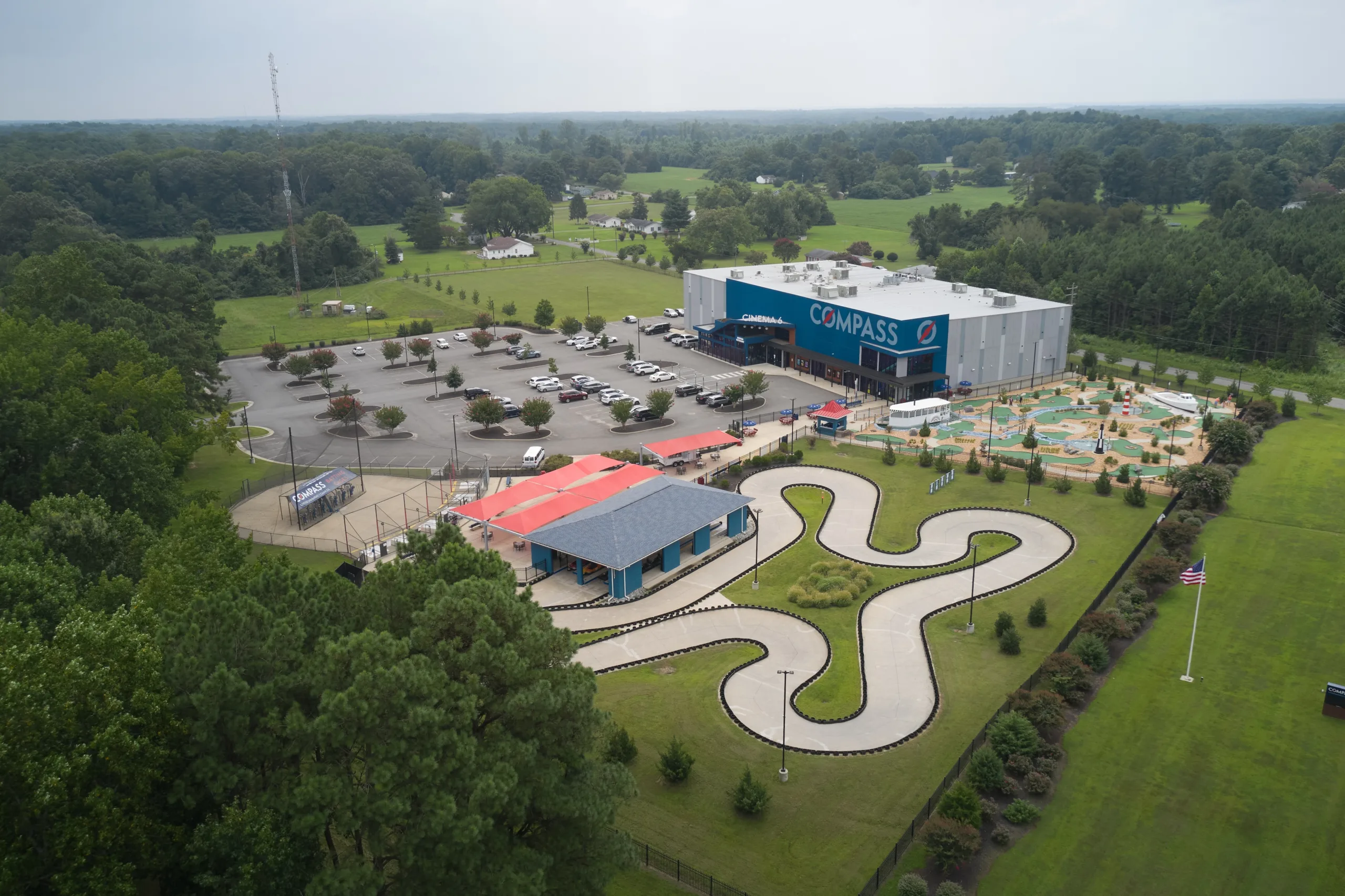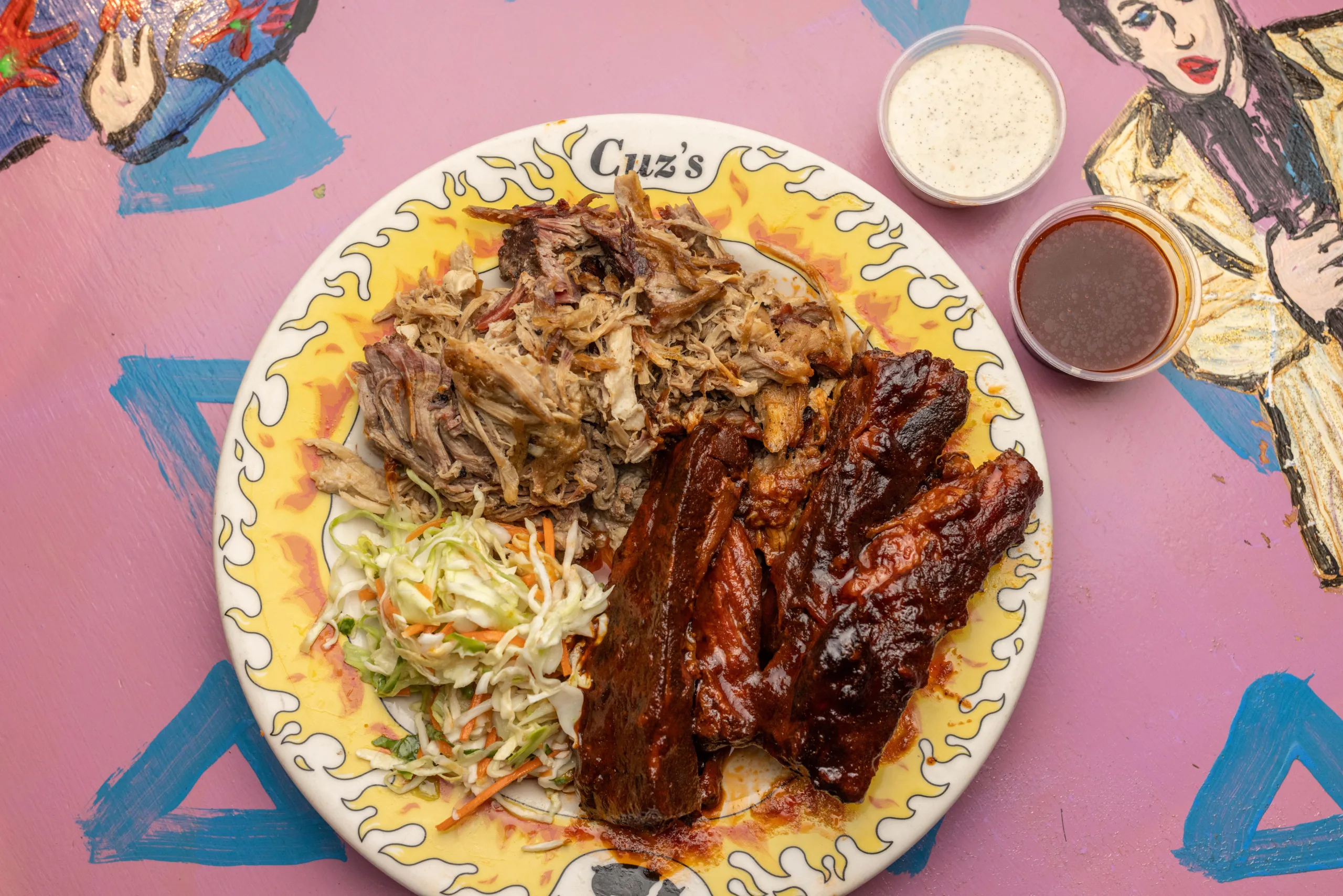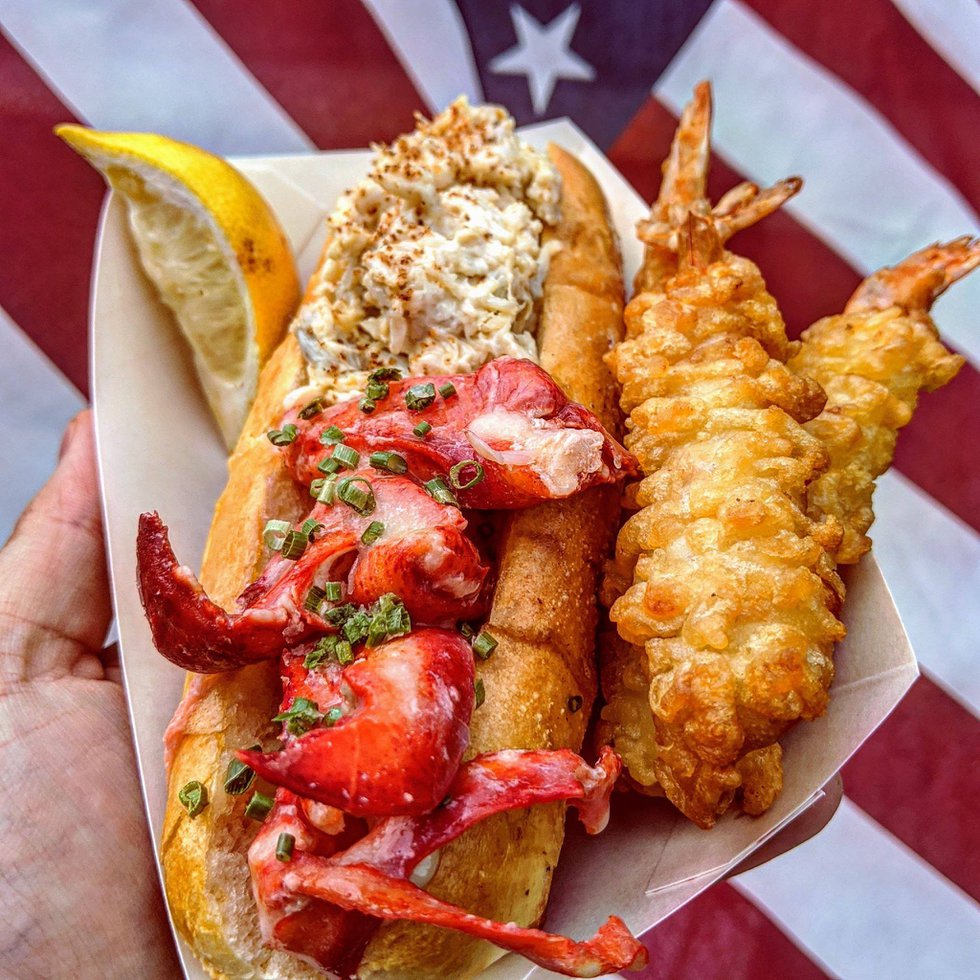It’s high summer in Rappahannock County, and everything feels abundant. The grass is charging upwards, crested by weeds and wildflowers. Birds and bugs vie for who can chirp loudest. And the sky over the Shenandoah Valley is a clear azure, dotted with cotton-ball clouds. It’s here, on this unlikely mountaintop in Sperryville, where you’ll find Sumac, a dining concept recognized in 2024 by The New York Times as one of the 50 best restaurants in the country.
To the untrained eye, Sumac—a retrofitted trailer with a screened-in porch plopped in the middle of an open field—looks like an afterthought. But in fact, Sumac, as a concept and in practice, is all about forethought and attention to detail. The small team of cooks led by owner and Chef Dan Gleason must anticipate the growing season, the weather, and the whims of a live fire, and then work with those elements to produce innovative plates for every single service.
Located on the property of Pen Druid Brewing, an operation whose spontaneous, barrel-fermented native beers are the perfect accompaniment to Sumac’s dishes, the trailer serves as the brewery’s de facto kitchen. Within the trailer, Sumac’s chefs are producing the kind of plates you’d expect from a Michelin-starred restaurant but in the most casual digs imaginable—no white linens, no sommeliers humming in your ear, none of the pomp and circumstance of traditional fine dining. And it is a revelation.
Sumac is built on three main pillars. Foremost among them is that 100 percent of all of the proteins, vegetables, dairy, and grains (in short, everything) served at Sumac comes from within 150 miles of the restaurant, often much closer than that. Beyond that mandate, there is also an embracing of the wild. The name Sumac references Gleason’s first edible discovery as he foraged the woods around his Maryland home as a kid, and much of Sumac’s menu features foraged ingredients that have been pickled, fermented, or otherwise preserved. And then there’s the live fire—as much an ingredient as the food itself; the fire, which Sumac’s chefs must kindle daily no matter the conditions, lends its smoke and char, its very personality, to nearly every dish on the menu in one way or another.
On my maiden voyage, the first plate to land on my weathered picnic table makes it clear that these chefs have mastered the art of live-fire cooking. There, on a rectangular plate, are three skewers, each better than the last—a cross-hatched eggplant, seared to a burnished golden brown, flanked by a crispy-skinned filet of mackerel on one side and, on the other, a deftly charred chicken hatsua traditional Japanese yakitori preparation of skewered chicken hearts—accompanied by a smoky romesco sauce.
The plates that follow continue the story. Tuna crudo is plated with precise panes of fresh watermelon that mimic the bright red color of the fish; it swims atop a tangy puddle of rice milk dotted with foraged spice bush oil. A generous slab of summer’s finest heirloom tomato is briefly charred and then gilded with a wheat-yellow corn cream and pickled mustard seeds. There’s wood smoke-scented khachapuri—a cheese-filled bread of Georgian origin—draped with a Basque-style aged goat cheese called Cabra LaMancha and tissue-thin slices of house-made cured pork loin, known as lonzino.
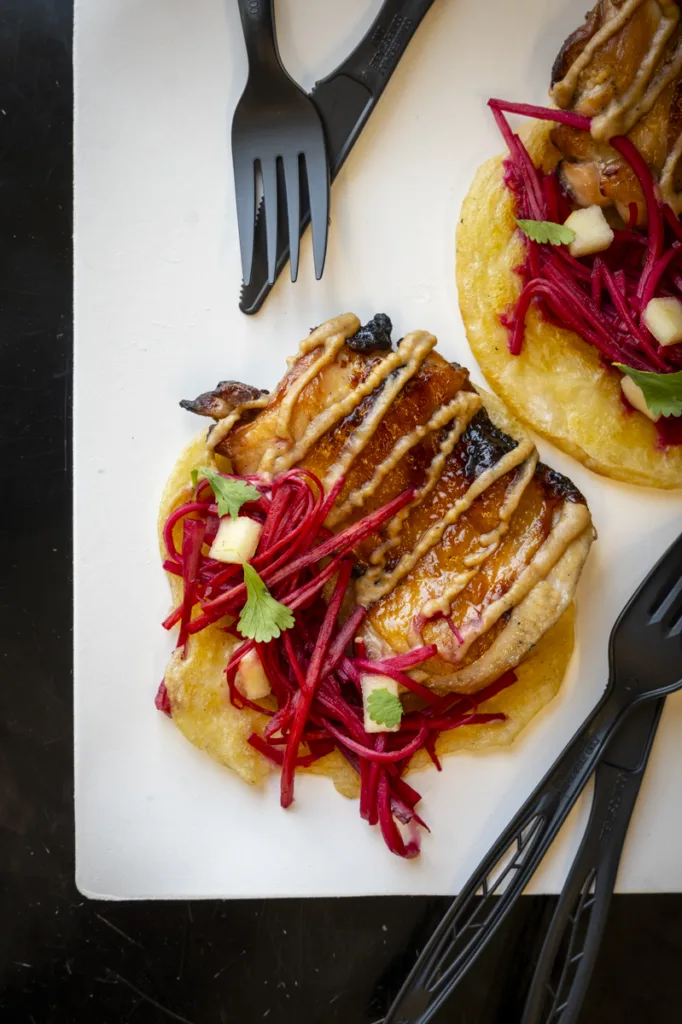
Smoked chicken with white molé atop a sourdough crêpe with apple and rhubarb. Photography by
Scott Suchman
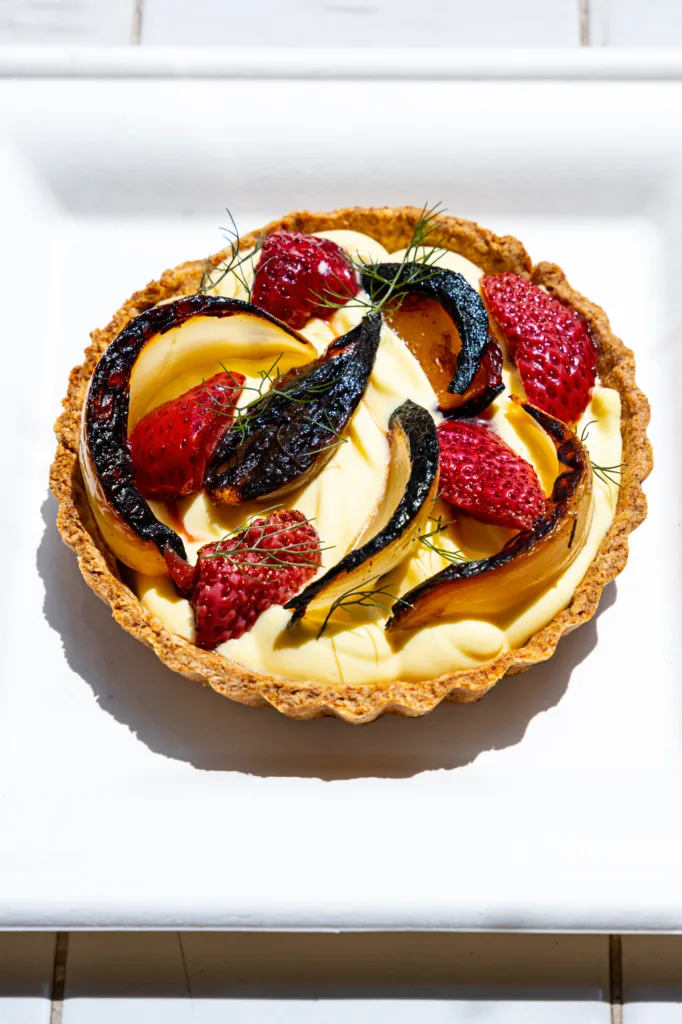
Spring galette with strawberry and vidalia onions.
The sturdy paper plates are hand-delivered by the chefs who just prepared them, a blessing if you happen to have questions about any of the lesser-known ingredients; skip the middleman and go straight to the maker, all of whom are refreshingly verbose when it comes to explaining the plates before you.
I’m never surprised to see chefs working in close quarters. I’ve often found that the best chefs practice an economy of movement characterized by a kind of self-contained ballet. But Sumac’s ersatz kitchen is especially tight, and this keeps its handful of chefs locked in their stations. The screened-in porch houses the hearth, which Gleason built by hand with friends. In the trailer, there’s a prep station that doubles as the cold line that looks out the window where guests place their orders. The trailer’s walls are lined with a trove of fermenting jars filled with pickled grape leaves, chanterelles preserved in everclear, and other unknown treasures, above which you’ll see a bookshelf that’s a veritable syllabus for fermentation-friendly chefs—The Artusi Cookbook, Nigel Slater’s Kitchen Diaries, Harold Mcghee’s On Food and Cooking, and of course, The Art of Fermentation—reference manuals for the wild-inclined.
When the mission is to source everything on the menu from the closest farms possible, the relationship with farmers becomes essential. Nothing is coming off a purveyor’s truck at Sumac. It’s delivered by the same hands that have harvested it, often just hours before, from neighbors at farms like Next Step Produce, Fireside Farm, and Jenkins Orchard. In a world of farm-to-table lip service, Sumac is drawing a line in their sandy loam soil. “We work very closely with all of our farming partners,” says Gleason. “We’re cooks, not farmers, but it feels like we are very much a part of their system because of our sourcing practices.”
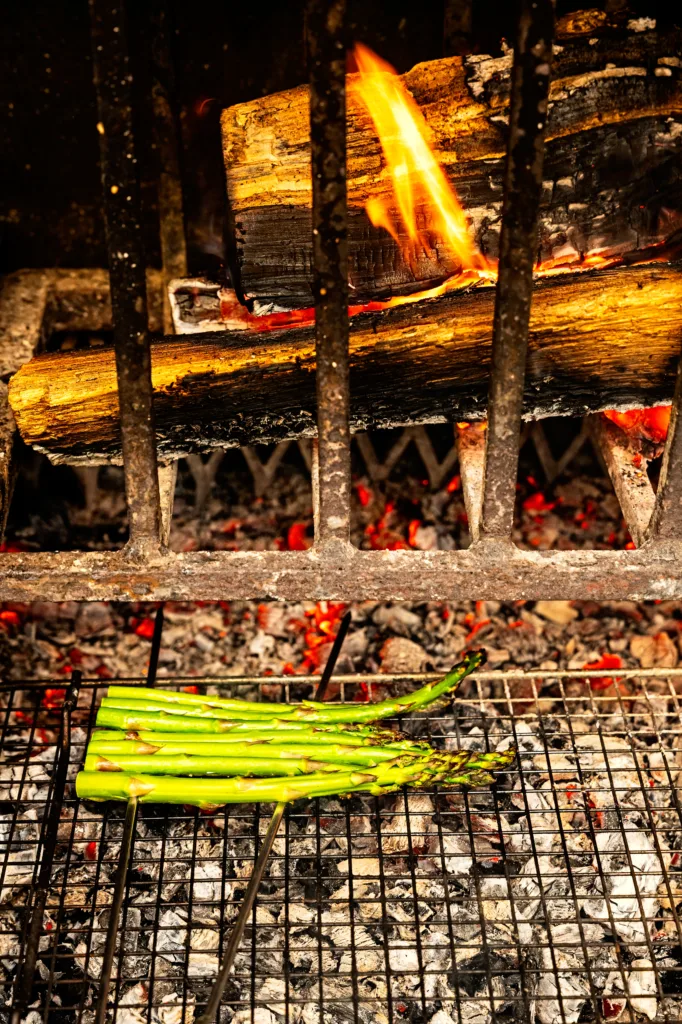
Sumac’s wood-fire grill imparts flavor and depth to fresh and local asparagus.
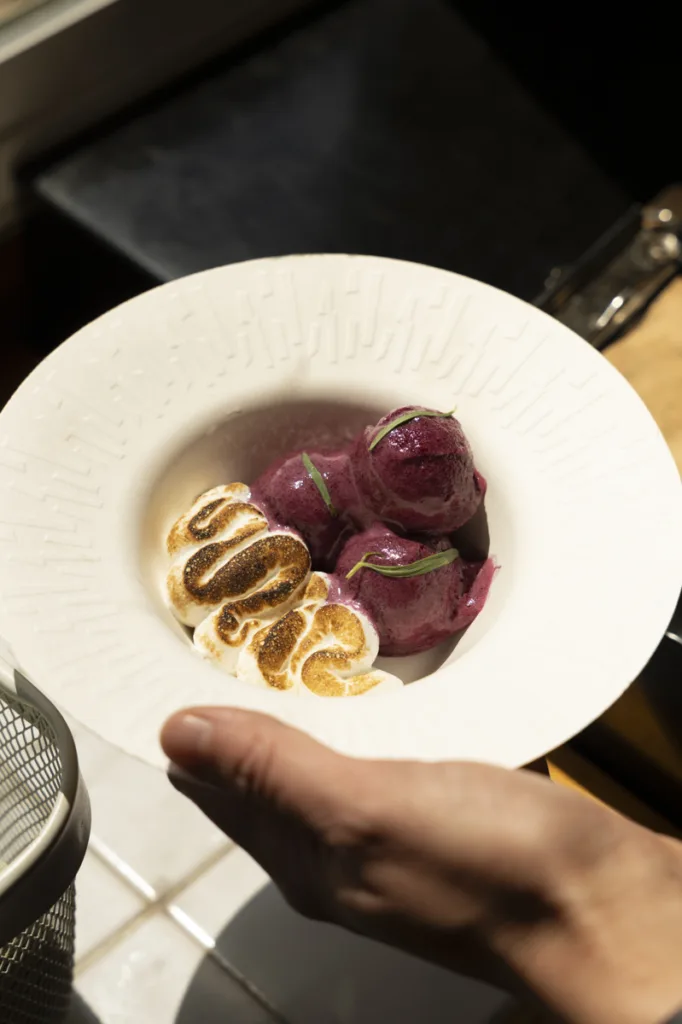
Grape sorbet with honeysuckle meringue.
Gleason says, now going on his fifth year at Sumac, he’s refined his awareness of the natural world so much that he feels a bit like a walking almanac. His appreciation for the rhythms of the seasons helps Gleason and his team anticipate where the menu is heading next, and it helps them establish trust with the farmers they work with. “I finally feel like, when I talk with the farmers, they trust me in a way that they trust their own. Farmers are so in touch with the elements and the weather, and, because we’re outside, dealing with it in a way that’s similar to them, I can sort of talk the talk with them.”
This is the kind of chef-driven restaurant where I wouldn’t be surprised to find a sparse, simple dessert offering—something sweet and uncomplicated to round out an otherwise extraordinary meal. But instead, I’m delighted to find a thoughtful, memorable dessert that showcases peak summer peaches by presenting them on top of a sweet corn cake with a luscious, soft peach crème anglaise. In the bottom of the bowl, there’s a subtly spiced peanut caramel that mirrors and amplifies the sweetness of the fresh peaches on top, creating a bite that makes me immediately scoot the bowl closer. There’s only one dessert, but what a dessert it is.
If you’ve made your way to the top of Sperryville Pike to find Sumac and Pen Druid Brewery, you owe it to yourself to order the entirety of Sumac’s menu—about eight small plates total, including dessert. Get cozy on a picnic bench overlooking the valley while enjoying a tart and bracing draft from Pen Druid. And give thanks that, in a world where so much is micromanaged, controlled, and regulated, some things are still blissfully wild.
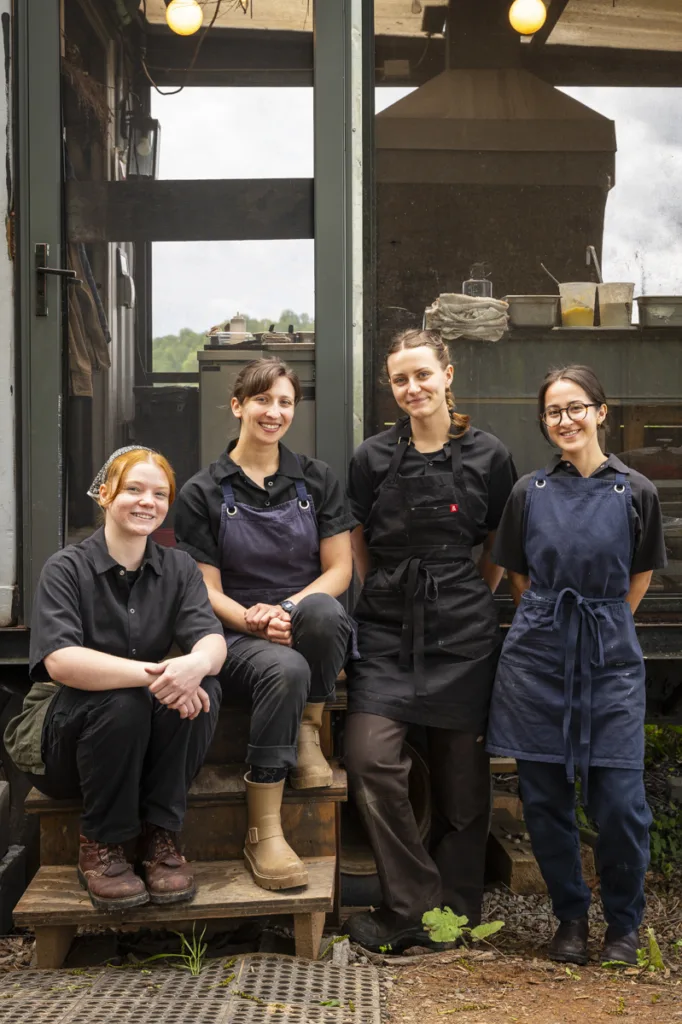
Kitchen staff, L-R: Laila-Marie Hall, Chef de Cusine Haley Herrinton, Charlotte Zerbst, and Elizabeth Lira.
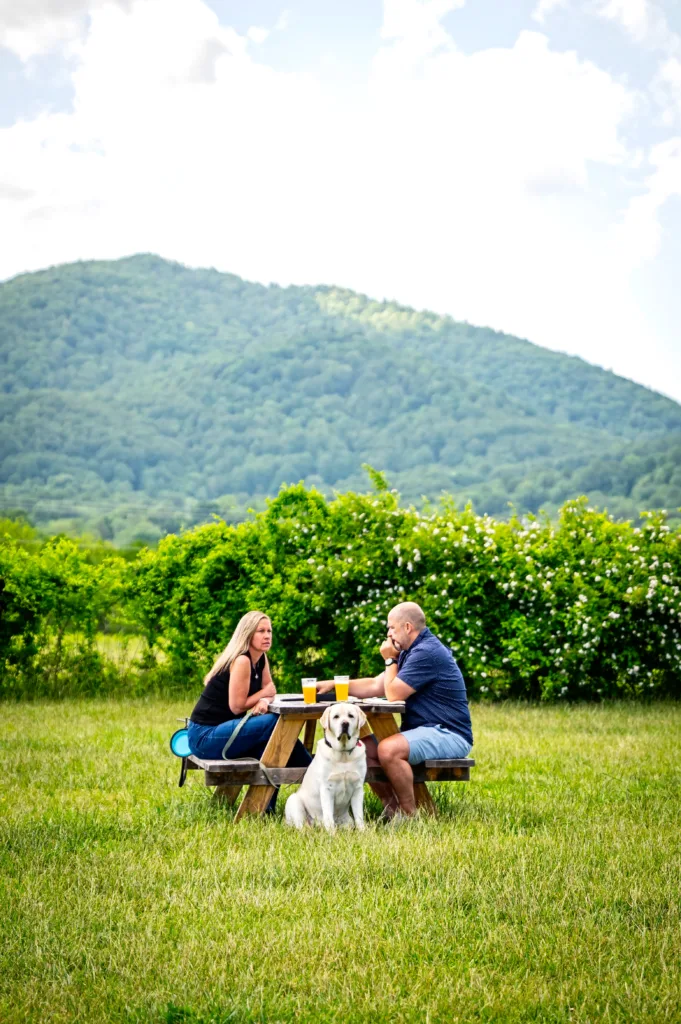
Sumac guests can eat inside Pen Druid Brewing or enjoy dining al fresco with stunning mountain views (and well-behaved canines).
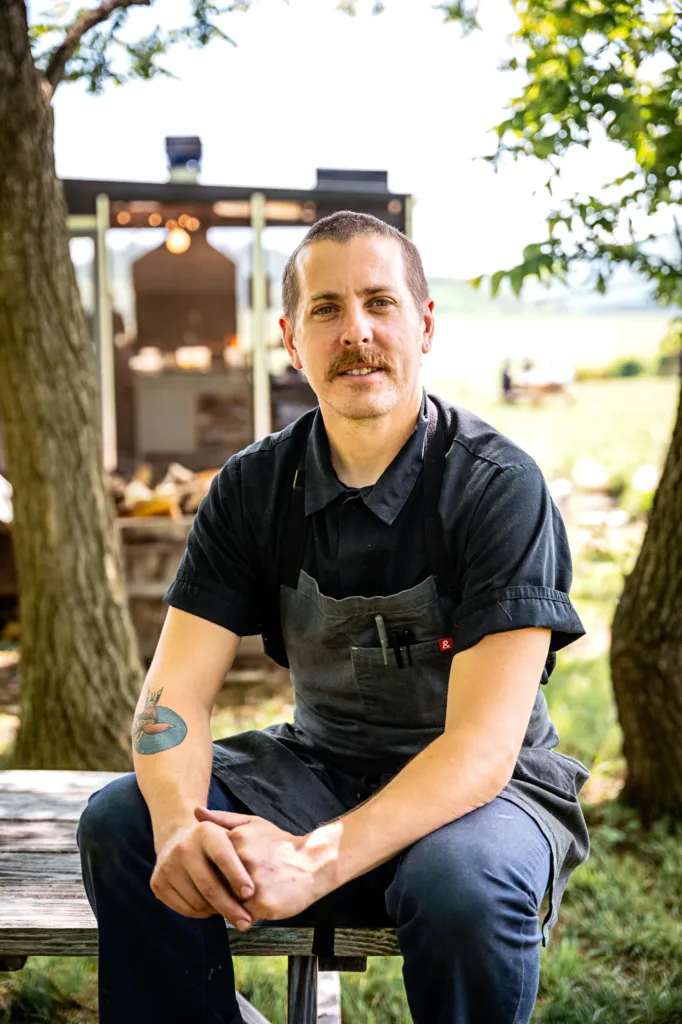
This article originally appeared in the August 2025 issue.
